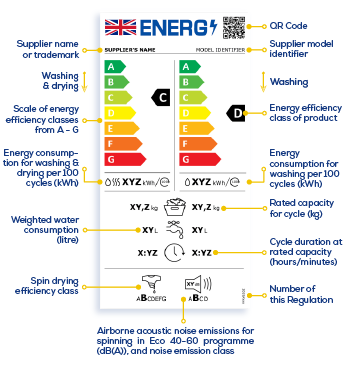Energy Labels
 |
When purchasing a new appliance, there are several factors to consider, including size, brand, and color. However, energy efficiency is an important consideration that can reduce your carbon footprint and save you money. The energy label has led to significant advancements in energy-saving technology, resulting in top efficiency ratings for all new products. As a result, the label has been recalibrated to facilitate comparisons between appliance models. Why the New Energy Label? In 2020, the UK introduced a new energy label, spreading energy performance over a broader scale to make it easier to compare efficiency across products. It establishes higher standards for energy-saving appliances, promoting further savings while supporting manufacturers' and government environmental commitment |
|
Examples of the previous and new labels are compared, highlighting the following key changes across all product categories:
In addition, there are specific changes to each category, which are detailed below. Do you have any questions?
|
 |
Category Specific Labels
 |
 |
 |
Washing Machines & Washer DryersMore than 55% of washing machines placed on the EU market are ranked A+++ on the label, making it difficult to differentiate between products. How will the changes help?
|
Fridges & FreezersHalf of domestic refrigeration appliances placed on the market in 2014 could claim one of the top two energy ratings (A++ or A+++). How will the changes help?
|
DishwashersMore than 60% of dishwashers placed on the EU market ranked A+++ or A++ on the label, making it difficult to differentiate between products. How will the changes help?
|
For further information about how the new labels are being displayed on appliances.






